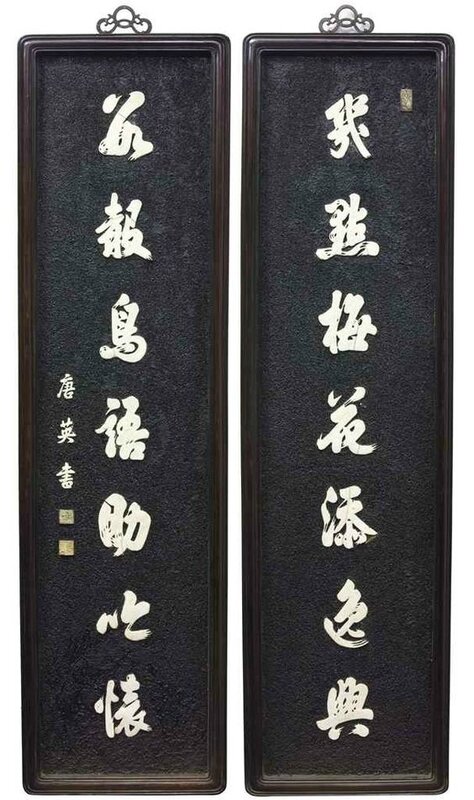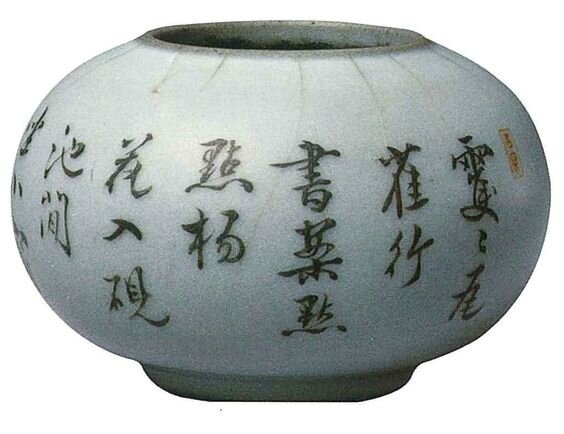A very rare pair of porcelain-inlaid calligraphic panels, Qing dynasty, 18th century, signed Tang Ying
Lot 2012. A very rare pair of porcelain-inlaid calligraphic panels, Qing dynasty, 18th century, signed Tang Ying. Estimate HKD 1,800,000 - HKD 2,500,000 (USD 232,985 - USD 323,590). Price realised HKD 6,030,000 (USD 780,426) © Christie's Images Ltd 2013
The rectangular panels are each inlaid with seven large white-glazed porcelain characters in cursive script to form a couplet. The right column is preceded by an unglazed seal; while the left column is followed by three smaller character Tang Ying shu, 'Calligraphy by Tang Ying', and two further seals, all reserved on a black ground applied with a textured background within hardwood frames and fixed with hanging brackets. Each plaque 63¼ x 17¼ in. (161 x 44 cm.) (2)
Provenance: Taji Shuichi Collection
Literature: Taji Shuichi, Porcelain of the Ch'ing Dynasty, Tokyo, 1976, no. 164.
Note: The couplet can be translated:
Speckles of prunus flowers add to my leisurely mood;
A smattering of bird songs relieves my laboured heart.
The seals are:
Yuci yujin jicui: Imperial gift; Deep Gold and Dense Green
Tang Ying zhiyin: Seal of Tang Ying
Jun Gong (a sobriquet of Tang Ying)
The supervisor of the Imperial kilns at Jingdezhen during the Yongzheng and Qianlong periods, Tang Ying (1683-1756), was not only one of the most efficient and innovative supervisors in the history of Chinese porcelain production, but also an accomplished calligrapher and poet. This very rare pair of panels is a fine example combining his three favourite subjects: porcelain, calligraphy and poetry. They show the consummate skills of the Jingdezhen potters to convey calligraphic brush strokes in clay. The characters are so masterfully rendered that on first glance they look as if indeed written by a brush. The fluidity of the strokes, the composition of the characters and the way the dry brush drags across the surface of the paper are all faithfully replicated in porcelain.
Excavations from the Imperial kiln sites at Zhushan in Jingdezhen have yielded similar porcelain shards of characters, as well as an unglazed seal with the mark 'Jun Gong' (Tang Ying's sobriquet) which is identical to the seal found on the current panels. The phrase Yuci Yujin Jicui could be a poetic title (usually adopted by scholars) given to Tang Ying by either the Yongzheng or Qianlong Emperor. Although there are no published records in establishing whether the title was an imperial gift to Tang Ying, similar calligraphic titles were given by Emperor Kangxi to Tang Ying's predecessor at the Imperial kilns, Lang Tingji (1663-1715). Among these include: Buze xijiang, 'Wide Benevolence to the West River'; Yuci Chunyi Tang, 'Imperial Gift (for) the Hall of Pure Unity'; Qing Shen, 'Uncorrupt and Vigilant'. Lang Tingji had the Yuci Chunyi Tang marks inscribed onto porcelain, an example of which is a blue-glazed bowl in the Percival David Foundation illustrated by Ming Wilson in Rare Marks of Chinese Porcelains, London, 1998, no. 35, pp. 90-91.
The only other known pair of porcelain-inlaid lacquer panels with Tang Ying's calligraphy appears to be in the collection of Eisei Bunko Museum, Tokyo, illustrated in Chugoku Bijutsu Shiho ten, Tokyo, 1981, no. 59 (fig. 1). The writing style of the current panels is undoubtedly that of Tang Ying's, and closely compares to the calligraphy also written by him on a water pot now in the Palace Museum, Beijing, illustrated by Geng Baochang in Qingdai Yuyao Ciqi, Vol. I-b, Beijing, 2005, p. 9 (fig. 2). Note the characters 'hua' and ' dian' especially are written in exactly the same way on the panels and the water pot. Compare also to a small cup with Tang Ying's calligraphy sold in at Christie's Hong Kong, 1 December 2009, lot 1921.
fig. 1. A pair of porcelain-inlaid lacquer panels with Tang Ying's calligraphy in the collection of Eisei Bunko Museum, Tokyo.
fig. 2. A water pot with Tang Ying's callygraphy in the Palace Museum, Beijing.
Christie's. The Yiqingge Collection of Chinese Ceramics, 29 May 2013, Hong Kong

/https%3A%2F%2Fprofilepics.canalblog.com%2Fprofilepics%2F1%2F0%2F100183.jpg)
/https%3A%2F%2Fstorage.canalblog.com%2F03%2F02%2F119589%2F96711876_o.jpg)
/https%3A%2F%2Fstorage.canalblog.com%2F11%2F31%2F119589%2F94773502_o.jpg)
/https%3A%2F%2Fstorage.canalblog.com%2F20%2F83%2F119589%2F94772815_o.jpg)
/https%3A%2F%2Fstorage.canalblog.com%2F26%2F72%2F119589%2F75604929_o.jpg)
/https%3A%2F%2Fstorage.canalblog.com%2F59%2F60%2F119589%2F26458628_o.jpg)





/http%3A%2F%2Fstorage.canalblog.com%2F21%2F96%2F119589%2F129836760_o.jpg)
/http%3A%2F%2Fstorage.canalblog.com%2F33%2F99%2F119589%2F129627838_o.jpg)
/http%3A%2F%2Fstorage.canalblog.com%2F07%2F83%2F119589%2F129627729_o.jpg)
/http%3A%2F%2Fstorage.canalblog.com%2F28%2F37%2F119589%2F129627693_o.jpg)